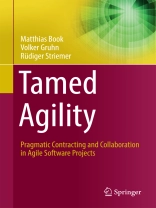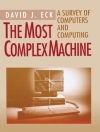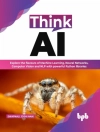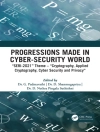This book describes pragmatic instruments and methods that enable business experts and software engineers to develop a common understanding of the software to be created, to determine their key requirements, and to manage the project in a way that fosters trust, encourages innovation and distributes risk fairly between clients and contractors.
After an introduction to the fundamentals of agile software development in Part I, Part II describes the Interaction Room, an actual room where digitalization and mobilization strategies are developed, where technology potentials are evaluated, where software projects are planned and managed, and where business and technical stakeholders can communicate face to face, visualize complex relationships intuitively, and highlight value, effort and risk drivers that are keys to the project’s success. After addressing these constructive aspects, the book focuses on the commercial aspects of software development: The ad VANTAGE contract model described in Part III ensures that the insight-driven innovation process of software development does not just function, but is allowed to flourish in a trusted client-contractor relationship. Even though software contracting and construction may be grounded in two different academic disciplines, they are inseparable in practice, and how they interact is illustrated in the case study of developing a private health insurance benefit system in Part IV. Ultimately though, the success of every software project depends on the skills of the stakeholders. Part V therefore describes the qualification profile that software engineers and domain experts have to satisfy today.
This book is aimed at CIOs, project managers and software engineers in industrial software development practice who want to learn how to effectively deal with the inevitable uncertainty of complex projects, who want to achieve higher levels of understanding and cooperation in their relationships with clients and contractors, and who want to run lower-risk software projects despite their inherent uncertainties.
Tabela de Conteúdo
Part I: Introduction. – 1. The Need for Tamed Agility.-
Part II: The Interaction Room. – 2. A Room for Ideas.- 3. Interaction Room Basics.- 4. Using an Interaction Room for Digitalization Strategy Development (IR:digital).- 5 Using an Interaction Room for Software Project Scoping (IR:scope).- 6. Using an Interaction Room for Mobile Application Development (IR:mobile).- 7. Using an Interaction Room for Technology Evaluation (IR:tech).- 8 Using an Interaction Room for Agile Project Monitoring (IR:agile).- 9. Using Interaction Rooms Under Difficult Conditions.- 10. Summary.-
Part III: The ad VANTAGE contract model. – 11. Framing Software Projects in Commercial Terms.- 12 Traditional Contract Models in an Agile World.- 13. Agile Contract Models.- 14. Key ad VANTAGE Principles.- 15 ad VANTAGE Procedures.- 16. ad VANTAGE in Practice.- 17 Summary.-
Part IV: A Sample Project. – 18 Case Study: The Cura Health Insurance Benefit System.- 19 Initial Project Scoping with the IR:scope.- 20 Project Monitoring with the IR:agile.- 21 Lessons Learned.-
Part V: Conclusion. – 22 The Big Picture.- 23 A New Skill Set.- 24 Outlook: Twelve Hypotheses.-
Appendix. – 25 Interaction Room Workshop Agendas.- 26 Interaction Room Annotations.- 27 ad VANTAGE Contract Template.-
Index.
Sobre o autor
Prof. Dr. Volker Gruhn holds the Chair for Software Engineering at the University of Duisburg-Essen. His research focus is on methods for industrial software engineering, as well as the effects of digital transformation on enterprises. He co-founded adesso AG in 1997 and is chairman of the supervisory board today.
Dr. Matthias Book is Associate Professor for Software Engineering at the University of Iceland. His research focus is on facilitating communication between business and technical stakeholders in large software projects, and on pragmatic approaches to requirements engineering and modeling of complex software systems.
Dr. Rüdiger Striemer was member of the executive board of adesso AG from 2001 to 2015, and is heading the subsidiaries in Austria, Switzerland and Turkey as well as the company’s lottery division today. adesso is one of Germany’s leading independent IT service providers with more than 1700 employees in thirteen locations.












